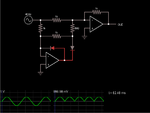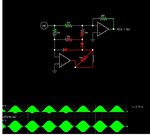uday mehta
Advanced Member level 4
I designed a Precise Full Wave Rectifier using op-amp. but there are some problems i am facing at high frequency
i) at high frequency i got some -ve voltage(may be due to reverse recovery time i don't know).
ii) positive pulse of it's o/p is amplitude dependent. i.e. at 200 mv i got o/p of positive pulse is less then 200 mv but at 2 volt i got o/p of positive pulse is more then 2 volt.
there is no problem with o/p of negative pulse.
I am using 10 Khz i/p frequency.
here is the circuit diagram.
I am using 10K in place of 1 K and 5 K in place of 500ohm.
i) at high frequency i got some -ve voltage(may be due to reverse recovery time i don't know).
ii) positive pulse of it's o/p is amplitude dependent. i.e. at 200 mv i got o/p of positive pulse is less then 200 mv but at 2 volt i got o/p of positive pulse is more then 2 volt.
there is no problem with o/p of negative pulse.
I am using 10 Khz i/p frequency.
here is the circuit diagram.
I am using 10K in place of 1 K and 5 K in place of 500ohm.

